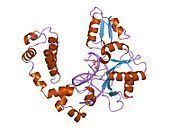Aliases POLB Ensembl ENSG00000070501 | Entrez 5423 Domain Mammal | |
 | ||
External IDs MGI: 97740 HomoloGene: 2013 GeneCards: POLB | ||
Kinemage dna polymerase beta
DNA Polymerase, beta, also known as POLB, is an enzyme present in eukaryotes. In humans, it is encoded by the POLB gene.
Contents
- Kinemage dna polymerase beta
- Stochastic path method applied to dna polymerase beta
- Function
- Regulation of expression
- Interactions
- Model organisms
- References
Stochastic path method applied to dna polymerase beta
Function
In eukaryotic cells, DNA polymerase beta (POLB) performs base excision repair (BER) required for DNA maintenance, replication, recombination, and drug resistance.
Regulation of expression
DNA polymerase beta maintains genome integrity by participating in base excision repair. Overexpression of POLB mRNA has been correlated with a number of cancer types, whereas deficiencies in POLB results in hypersensitivity to alkylating agents, induced apoptosis, and chromosomal breaking [ref7]. Therefore, it is essential that POLB expression is tightly regulated.
POLB gene is upregulated by CREB1 transcription factor's binding to the cAMP response element(CRE) present in the promoter of the POLB gene in response to exposure to alkylating agents. POLB gene expression is also regulated at the post transcriptional level as the 3’UTR of the POLB mRNA has been shown to contain three stem-loop structures that influence gene expression. These three-stem loop structures are known as M1, M2, and M3, where M2 and M3 have a key role in gene regulation. M3 contributes to gene expression, as it contains the polyadenylation signal followed by the cleavage and polyadenylation site, thereby contributing to pre-mRNA processing. M2 has been shown to be evolutionary conserved, and, through mutagenesis, it was shown that this stem loop structure acts as a RNA destabilizing element.
In addition to these cis-regulatory elements present within the 3’UTR a trans-acting protein, HAX1 is thought to contribute to the regulation of gene expression. Yeast three-hybrid assays have shown that this protein binds to the stem loops within the 3’UTR of the POLB mRNA, however the exact mechanism in how this protein regulates gene expression is still to be determined.
Interactions
DNA polymerase beta has been shown to interact with PNKP and XRCC1.
Model organisms
Model organisms have been used in the study of POLB function. A conditional knockout mouse line called Polbtm1a(KOMP)Wtsi was generated at the Wellcome Trust Sanger Institute. Male and female animals underwent a standardized phenotypic screen to determine the effects of deletion. Additional screens performed: - In-depth immunological phenotyping
